It can also be done like this: Model building in 1:45
- on wheel sets and track in Proto:45
by Erik Olsen
In Signalposten, volume 17, number 4, Holtrup poured out his troubles to want of articles: More on model railways. I thought that I ought to come our poor editor to aid, and grabbed inside the drawer after one of my projects: That one I should be able to write something about. On the other hand I was not so sure that the subject would be well received by the readers. Have I not frequently heard from average modellers that articles from rivet counters should not be published in Signalposten? Well, there ought to be room for us all, so I risk my skin: Listen....
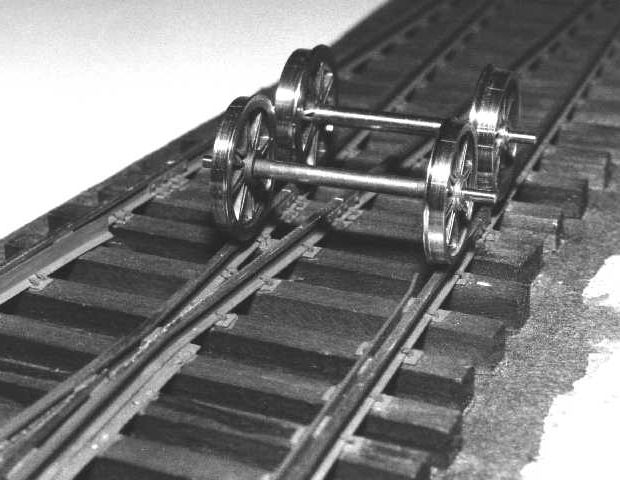
In the late 1960ies in Great Britain a group of railway modellers gathered who built in 4 mm scale (4mm/1foot = 1:76.2) with 18mm gauge, called EM gauge. This group was interested in whether it was possible to manufacture and use exact-scale wheelsets, track and switches in 4mm scale. The group formed a more formal organisation, The Model Railway Study Group (MRSG), the aim of which was to tell about their experiences to other modellers. The group's work resulted in standards for 4mm scale/18.83mm gauge, and in a long series of articles, among others in Model Railways, the group presented its experiences to other modellers. Not just the theoretical side was discussed, but also many practical problems and feasible solutions were indicated. This system the group called Protofour (P4).
Since then much occurred around Protofour: Besides The Protofour Society a competing association The Scalefour Society which called their system Scalefour (S4), though the differences as far as I know are small. Rivalry caused a lot of quarrel and debate in the model press which seemed a little unworthy and senseless, but which probably has done a great deal to make P4/S4 known. More essential, however, was that the P4-people through a company, Studiolith Ltd., started a production of parts, wheelsets, w-irons, and systems for suspension and springing of coaches, wagons and locomotives and gearboxes among others. Hence it became possible to the modeller without a lot of special tools, lathe etc. two build in P4/S4. Since then many other companies have taken up production of parts in 18,83mm gauge parallel to the traditional gauges 16.5mm and 18mm in 4mm scale. Today there can be had a selection of parts in 18.83mm gauge, which we in Denmark would find overwhelming.
The articles on P4/S4 fascinated me, and I considered attempting something similar in 1:87 scale. At that time I had built in 1:45 scale to NEM standards for some years, and it was lack of space which made me choose 1:87 scale. A number of wagon wheelsets in 1/87 scale was made and a number of ready-to-rum models modified and tested. Apparently it functioned well, and I bought rail so that I could build a little track and some switches. I was, however, not completely content, something was missing. I came to realise that I had got accustomed to the big models in 1:45 scale, now 1:87 seemed hopelessly small. It was an odd experience, among other things because I originally began in N gauge, 1:160 scale! I took the consequence by choosing 1:45 scale for my further efforts, and I had a few models, which I was able to modify. The lack of space problem is postponed to a/an distant future. Erik Juul-Pedersen said to me when I told him that I had dropped the 1:87 scale tests: Once 0 gauge, always 0 gauge .....
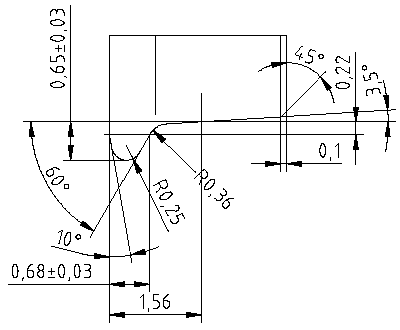
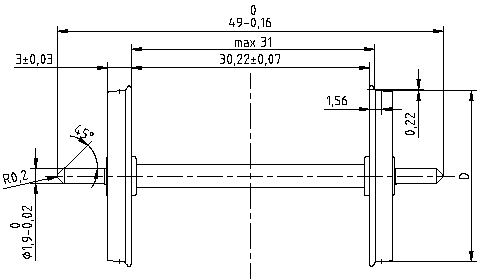
I laid down measures and allowable deviations for wheelsets and track, made a number of wagon wheelsets and modified two of my models, which together with a new wagon convinced me it is possible to use wheelsets in exactly 1:45 scale. Since I made a switch with the right guard and wing rail distances, and look! The wagons could be run along it without derailing. The measures of wheel rim cross section, wheelsets and guard and wing rails was laid down on the basis of DSB's measures and allowable deviations because of wear. It turned out that the allowable deviations can be made big enough that the construction is not unduly difficult. The allowable deviations are actually in the same order of size than those laid down by the NEM standards. Figures 1-4 shows measures and allowable deviations for wheel rim cross section, wheel set, and guard and wing rails.
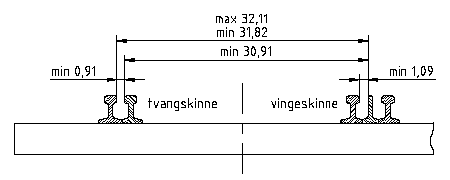
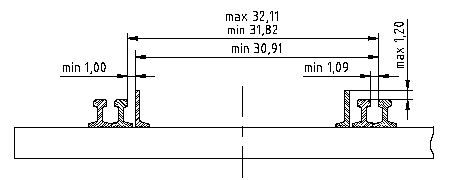
Photo 1 shows two wheelsets placed on a switch. The hindmost is in accordance with DMJK's standards (matching the NEM standards) with 1mm flange height, 4.7mm wheel rim width and 28.4mm back-to-back distance. The foremost is in accordance with figures 1 and 2 and has 0.7mm flange height, 3.0mm wheel rim width and 30.2mm back-to-back distance. As can be seen there is not much difference between the two wheel set's width across outside faces; as I had furthermore chosen the same axle length as in DMJK's standards, the replacement didn't cause any problems. (Remark: I have since altered the axle length to 49 mm and rounded-off points as shown in figure 2; with the older squared-off axles I put a 1mm bearing ball at each end, thus the total lengths are the same). Both modified models have sprung wheelsets, but a rocking suspension can also be used. Rigid suspension cannot be used with this small flange height, but I haven't tried.
The rail crossing is built after figure 3 allowing trouble-free passage of the foremost wheel set, while wheelsets to NEM standards naturally cannot pass. The switch is built using DSB-drawings of a 1:7.5 switch in tack type V, model 1933, and as an attempt it was provided with sprung switch rails, tie plates etched from 0.3mm brass sheet and special guard rails milled from brass. Only the fishplates I am not pleased with, they are not functional and from plastic and will not last if used to connect two rail ends.
Photo 2 shows one of my recent wheelsets mounted on my first type Q van in 1:45 scale. At the same time I removed the automatic coupling (DMJK-type) and installed a new drawhook cast in white metal with a screw coupling in each end. The screw coupling consists of cast srew-with-nuts and shackles etched from 0.5mm brass sheet. The coupling is strong enough for normal operation; should one break the damage is not large, as I cast it myself and naturally have a small stock. On the wheelsets I can tell that the wheel rim is turned from free-cutting mild steel, the wheel centre turned and milled from brass and soldered inside the wheel rim. Both wheels are provided with bushes of polyacetal plastic (Delrin), the axle is from 2mm silver steel and the centre distance tube is from a piece of 3mm outside diameter brass tube. I have also made disc wheels, where the wheel centre is a disc from 0.5mm brass sheet pressed to the right shape in a pressing tool made from brass, and provided with a soldered-in hub. The whole thing is finish-turned afterwards.
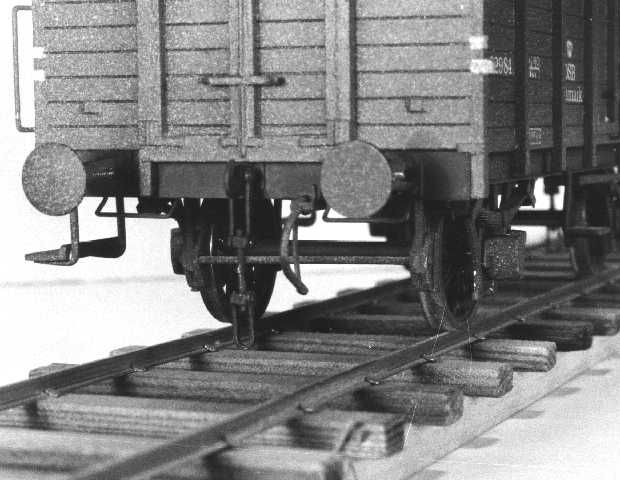
That was a little on my work with exact-scale model building in 1:45. For the time being I have at my disposal a Triangel motor coach, two completed wagons and one under construction, a switch and 1.5m of track. This has been unchanged in 1-1/2 year; I have not lost heart, it just waits that the inclination to build models shall turn up again. In the meantime I have a lot of other half-finished projects to work upon - and so what, it has to be fun, doesn't it?